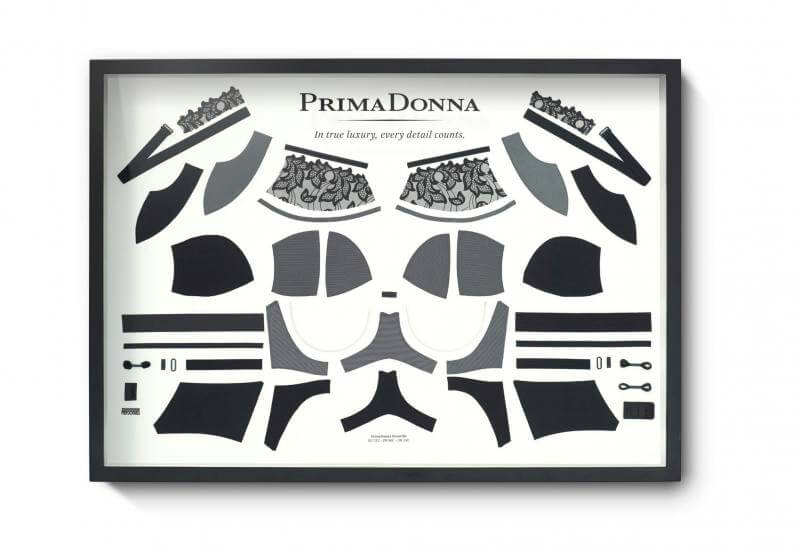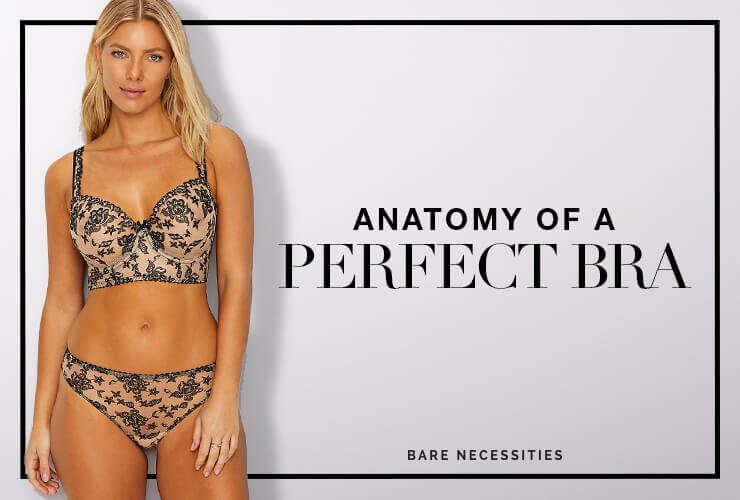Bras are one of those things in life that prove you get what you pay for. Because when there are $17 bras and there are $170 bras, there are differences.
So what makes a splurge bra so special? Bare Necessities asked Jennifer Conselyea, an industry veteran and regional manager for Belgian-based Van de Velde, parent company of luxury bra labels Prima Donna (for curvier figures) and Marie Jo (for average figures).
“It’s the difference between ready-to-wear and couture,” Jennifer said. “Every body is not the same, even in the same size. Prima Donna, for example, is a more generous, higher-coverage 34D than a Marie Jo 34D.” Said differently, they’re tweaking the bras to fit real bodies so that it never has to be the other way around.
Another advantage of pricier bras: consistency. “With a better line, you’ll know what’s going to work for you next season; with a cheaper line, you can’t always assume that,” said Jennifer, who recommended starting with a Bare Necessities Bra Fit Expert to figure out what will work best on your body rather than guessing.
“If you haven’t had a great bra before, the willingness to spend isn’t always there. And I know people wish there was, but there is no universal bra. One bra can fit you right yet not look good under your shirt. This is why we all need a bra wardrobe,” Jennifer said.
Read on for her explanation of bra benefits….
THE COMPONENTS
A high-end bra can easily have 50 or more parts, and 40-plus steps go into making a single garment. The difference, as always, is in the details.
Take underwire bras: Apart from using stainless steel—not cheaper nickel, which can irritate skin—each wire comes wrapped in foam, then gets another layer wrapped over that. Every wire is different, too: 72 discrete sizes of the Deauville bra means there are 72 wires of slightly different lengths that go into the cups, whereas a lesser brand might use sister-size wires (i.e. the same length on both a 36D and a 38C). The wire also varies with the type of bra, whether it’s a balconette with a shorter one or a full-cup with a longer one.
With Prima Donna, the center gore isn’t just a triangle of fabric; it’s lined inside for strength and durability. Another thin piece of sheer tulle lining goes into the bra under the arms. Together, those pieces keep the underwire in place and help the bra last and last. Likewise, hardware (like clasps and strap adjusters) is made of metal, not plastic, and quality-tested.

“I still wear some of the bras I got when I started here ten years ago,” said Jennifer, who always recommends picking up a new one every few months to add into the rotation and further extend longevity.
THE FABRICS
Prima Donna employs people whose entire job it is to test things like degree of stretch and recovery in the elastic, or colorfastness and washability. The brand uses wider, more rigid elastics that snap back into shape, and more fabric in general to get every cut right. Van de Velde permits a .5mm allowance (depending on the fabric); a cheaper brand will have a wider margin of error.
All fabrics have to pass a tolerance test before they’re cut. “If it doesn’t pass, we reject the whole lot of fabric,” said Jennifer.
Most materials are sourced from the finest European suppliers (French lace; Swiss embroidery); Van de Velde is also experimenting with up-and-coming textile producers like Japan. “It’s amazing what the fabrics go through before they come to us,” said Jennifer. “We go with the best because it really makes a difference in this size range.”
And all these fabrics have a seal from Oeko-Tex, a third party that verifies the materials are safe for you and the planet and—bonus!—won’t cause an allergic reaction.
DESIGN & PRODUCTION
The lead time on a new design is generally 18 months—the antithesis of fast fashion—and there’s a lot of back-and-forth between the designers and suppliers. Twice a year, the North American sales team visits Belgium to review prototypes and discuss what customers are looking for.
“Design is very technical, even incorporating the degree of stretch. A cheaper brand has one pattern, and it gets scaled from a B-cup up to an H-cup. We have multiple patterns, at least three, so we’re scaling B to D, E to G and H to J. Some of our most popular bras can’t extend any further because the pattern won’t allow for it—it’s actually easier to make a whole new bra,” Jennifer explained. “Within the same size, you may find multiple cuts to suit different body types,” Jennifer said. “In Prima Donna, we have full 3-part-cups, a balconette shape and a T-shirt bra all in the same style group. There’s graded, and then there’s different patterns, and doing it right makes all the difference.”
Everything is cut in Belgium by Van de Velde’s own employees. Details like the pretty edging on the Madison bra’s cups is done by a special machine so that the scalloping is exactly the same; all the excess falls away.
“There are so many things you don’t even see,” said Jennifer. “If you were to flip the seams, they’re sewn down in two spots, which takes a whole extra line of stitching, but flat seams make the bra more comfortable, with less puckering. The finished look is very different than a Victoria’s Secret T-shirt bra.”
THE FACTORIES
“China has the best factories and the worst,” said Jennifer. “The good ones, you never hear about.” Naturally, those are the ones Van de Velde partners with. In fact, they own stake in them. “When you do, you have control, and you keep that factory afloat so we can keep buying from it.” Within a factory, “each person does one job, and they do it well, be it a strap or the upper cup. They’re hand-done to a degree. Fabric is handled by impossibly precise digital machines, the latest tools out there, which lay out the pattern to align perfectly and save material.”
BRAND HERITAGE
Prima Donna started way back in 1919 as a private-label brand run by a husband-and-wife team in Germany. “In the day, if they were making bras for you, it was from A to Z. They would go to your office, write it all down, go back to their workshop and make the bra then and there. The tags would even say the store they were made for,” said Jennifer.
In 1990, Prima Donna really brought the fashion dimension to the brand by introducing matching sets and pretty little touches. “The German market had a demand for bigger bands and cups, and we kept going with that,” per Jennifer. Now, the EU brand goes up to a size J.
THE SUPPORT
“Cheap materials won’t support very well, and they won’t last long,” reasoned Jennifer. “You want a bra to be moveable and breathable, to hold up over time. The band is most important for support. The side panels and under the cups are reinforced with hidden seams. The straps and upper cups don’t do as much work, so that’s where we can embellish more.”
And once you have a perfectly fitted bra that looks as pretty as it makes you feel, you can’t imagine wearing anything else. That’s really what makes a bra priceless.

8 replies on “Anatomy of a Perfect Bra”
I wonder why the horizontal band across the lowest part of the bra band is not
considered an important part of the sizing.
In my experience the fasteners at the back of this band are always too tight,
(even with the loosest fastener.) Usually there are three fasteners.
Do you know of any Companies who offer bras with a wider circumference giving a more comfortable fit?
Thanks for your comment, Carolyn! 85% of the support comes from the band, and getting a supportive bra would require a nice, snug band—but you should still feel comfortable! We’d be happy to discuss any fit issues you may be experiencing in depth over the phone. Please give one of our Bra Fit Experts a call at 1.877.728.9272 and select option 4. Thanks for reading and for shopping with us!
I have B cup but 39 around. Small shoulders and bra strap constantly sliding off. I’m a nurse so I need comfort not lace that scratches. Any suggestions?
Hi Betty, give us a call when you get a minute. We’ve got your band measurement, but that B-cup may not be exactly what you need. Our Bra Fit Experts are at the ready: 877-728-9272 x4. Talk soon!
I want a comfortable bra but one that holds me up. I lost a lot of weight quickly resulting in me losing my perky breasts. They now hang down like an old lady. What type of bra do you suggest?
Hi Judith! There are so many excellent bra possibilities for you out there. Give us a call (877-728-9272, x4) or chat with us online, and we can narrow it down to the best bets in your size and preferred styles. Looking forward!
I received my two bras I purchased today but really dislike the shape it gives me in a shirt—they seem to fit okay, but my breasts have more cone shape which I dislike. Any suggestions?
Hi, McCall! Thanks for reaching out. Our Bra Fit Experts located your order; the styles selected can tend to provide a pointy shape under some shirts. You might like to try a T-shirt bra, such as the Elomi Charley Spacer T-Shirt bra #EL4383. These styles typically give a more rounded appearance and a smooth look under most shirts. For more suggestions, please reach out to us at 1-877-728-9272 x4.